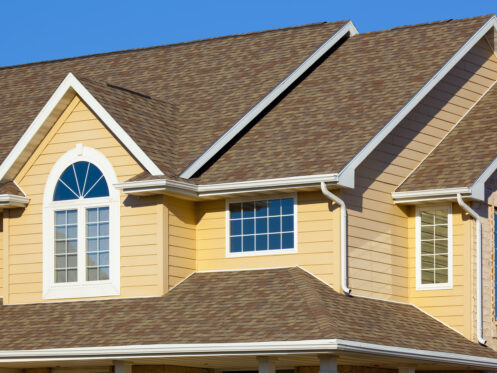Replacing your home’s siding is a significant investment likely to last you more than 50 years. The siding of your house plays a crucial role in its overall look and value. It shields the underlying structure from the elements and is critical to the building envelope. Choosing the right siding can enhance the comfort of your home, improve its energy efficiency, and reduce your month-to-month heating and cooling costs. Keeping these benefits in mind, let’s look at some of the innovative siding options available to you.
Fiber Cement Siding
Fiber cement is a popular siding material for both residential and commercial properties. James Hardie’s HardiePlank is the most trusted product in the market, thanks to the company’s innovation and replacement of asbestos with cellulose.
Fiber cement has many advantages, including low upfront costs, easy installation, and a lifespan of at least 50 years. It requires minimal maintenance, with the need to repaint every ten years or so. Some homeowners do it every five years to refresh their home’s curb appeal.
Fiber cement siding products come in various styles, including clapboards emulating natural wood. It offers your home excellent weather resistance and is one of the best fire and heat-resistant materials. It’s a top choice for areas prone to hurricanes and tornadoes, as it resists warping, rotting, and pests.
Engineered Wood Siding
Engineered wood siding has been in use for almost as long as cement siding, and it has undergone significant improvements in manufacturing processes. This material is a blend of adhesives and wood waste, such as sawmill scraps, making it a more environmentally friendly option than others.
Although engineered wood siding is generally less expensive than fiber cement, it typically lasts about 30 years, compared to 50 years with fiber cement. Most engineered wood siding comes pre-finished and requires repainting every ten years, similar to fiber cement.
One of the benefits of engineered wood siding is that it looks like actual wood siding. LP SmartSide is the leading product in this category, offering smooth wood finishes and cedar-grain textures. It is also one of the companies that guarantees a lifespan similar to fiber cement and provides a 50-year warranty.
Panel length is important when deciding between fiber cement and engineered wood siding. Fiber cement panels are available up to 12 feet in height, while engineered wood is available up to 16 feet. It can result in fewer seams and quicker installation, which can help you save time and money.
Vinyl Siding
Vinyl siding was introduced to the American market in the 1950s by manufacturers. It quickly gained popularity as it had impressively low initial costs compared to other siding materials. The value of vinyl siding continues to be true today. Vinyl siding usually lasts 40 years or more, making the total ownership cost generally superior. As a result, it has become the most popular siding material in North America.
Vinyl siding is primarily made of a plastic called polyvinyl chloride or PVC. The PVC resin makes up about 80% of the material, with the remaining 20% comprising materials that affect durability, flexibility, impact resistance, and color. Vinyl is also eco-friendly as it is recyclable and produces fewer greenhouse gases than fiber cement and engineered wood.
Traditionally, the biggest complaint against vinyl siding has been its aesthetic. However, this criticism has faded in recent years due to innovations that have allowed for more upscale designs. Today, vinyl siding comes in many styles, textures, and colors. Popular product lines also offer many features beyond basic clapboard, providing even more design flexibility.
Insulated Vinyl Siding
Vinyl siding has been criticized for its poor thermal efficiency and susceptibility to impact punctures. However, there is a solution to these issues: insulated vinyl siding. This type of siding has a rigid foam core, which enhances its thermal insulation and impact resistance. Although insulated vinyl siding is higher priced than simple vinyl siding, it is not too expensive and does not significantly increase the overall ownership cost.
The R-value of a material measures its ability to insulate, and standard vinyl siding has an R-value of 0.61. In contrast, insulated vinyl siding has an R-value of at least 2.0 and can go as high as 4.0. This results in more comfortable living spaces and lower monthly energy bills.
Moreover, the foam core of insulated vinyl siding makes it more resistant to impact damage. Traditional vinyl siding is prone to punctures caused by hail and other forms of impact, but insulated vinyl siding is less likely to be damaged. Insulated products also tend to have longer lifespans. Manufacturers reflect this by offering better warranties than traditional vinyl siding.
Othe Innovative Siding Options
Metal siding has become increasingly popular due to its versatility. Typically made from aluminum or steel, it can be easily molded to achieve the desired shape, which is impossible with other siding materials. In the past, aluminum siding was a popular alternative to wood siding in the United States. However, with advancements in manufacturing, there are now many more options for custom installations.
In addition to metal siding, composite siding materials, such as fiber cement and engineered wood, are also available. Some manufacturers are now mixing polymers and resins with crushed rock or fiberglass, while others are using 94% recycled synthetic fibers to create new siding products. We anticipate that this area of siding manufacturing will continue to see innovation in the coming years.
Mix and Match
Homeowners like yourself can use different materials and colors for siding and trimming for your home. A popular modern design trend is to mix and match materials and colors to create interesting contrasts. For example, pairing a dark-colored engineered wood siding with a light-colored stone facade can contrast color and texture.
If you prefer a more subtle contrast, consider using two shades of the same color, such as slightly darker trimming than the siding. Garage doors offer another opportunity to add distinction and can be painted in colors other than white. The design of your front door can also significantly impact the overall look of your home.
Many homeowners are using board and batten to accentuate gables. Vinyl siding products are also available in various veneers that mimic stone, brick, cedar, and other materials. These allow for upscale design elements that are much more affordable than genuine materials.
Local Siding Experts in San Antonio
If you’d like an innovative siding solution for your home in San Antonio, BELDON Roofing Company is here to help. We have more than 75 years of experience in this region. Our company installs all siding, including James Hardie HardiePlank and LP SmartSide. We have expert roofers who perform replacements, emergency repair services, and scheduled maintenance. Our team also installs seamless gutters with or without gutter guards, Pella replacement windows, and ProVia entry doors. Call us today or contact us online to schedule an on-site consultation or with any further questions about our services.

